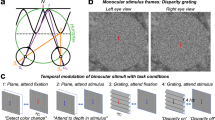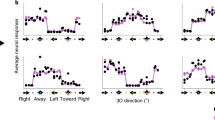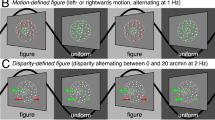Abstract
The spatial differences between the images seen by the two eyes, called binocular disparities, can be used to recover the volumetric (three-dimensional) aspects of a scene. The computation of disparity depends upon the correct identification of corresponding features in the two images. Understanding what image features are used by the brain to solve this matching problem is one of the main issues in stereoscopic vision1. Many cortical neurons in visual areas V1 (ref. 2), MT (refs 3, 4) and MST (refs 5, 6) that are tuned to binocular disparity are also tuned to orientation, motion direction and speed. Although psychophysical work has shown that motion direction7 can facilitate binocular matching, the psychophysical literature on the role of orientation is mixed8,9, and it has been argued that speed differences are ineffective in aiding correspondence7. Here we use a different psychophysical paradigm to show that the visual system uses similarities in orientation, motion direction and speed to achieve binocular correspondence. These results indicate that cells that multiplex orientation, motion direction, speed and binocular disparity may help to solve the binocular matching problem.
This is a preview of subscription content, access via your institution
Access options
Subscribe to this journal
Receive 51 print issues and online access
$199.00 per year
only $3.90 per issue
Buy this article
- Purchase on Springer Link
- Instant access to full article PDF
Prices may be subject to local taxes which are calculated during checkout




Similar content being viewed by others
References
Howard, I. P. & Rogers, B. J. Binocular Vision and Stereopsis (Oxford Univ. Press, New York, 1995).
Poggio, G. F. & Talbot, W. H. Mechanisms of static and dynamic stereopsis in foveal cortex of the rhesus monkey. J. Physiol. 315, 469–492 (1981).
Bradley, D. C., Qian, N. & Andersen, R. A. Integration of motion and stereopsis in middle temporal cortical area of macaques. Nature 373, 609–611 (1995).
Maunsell, J. H. & Van Essen, D. C. Functional properties of neurons in middle temporal visual area of the macaque monkey. II. Binocular interactions and sensitivity to binocular disparity. J. Neurophysiol. 49, 1148–1167 (1983).
Roy, J. P. & Wurtz, R. H. The role of disparity-sensitive cortical neurons in signalling the direction of self-motion. Nature 348, 160–162 (1990).
Roy, J. P., Komatsu, H. & Wurtz, R. H. Disparity sensitivity of neurons in monkey extrastriate area MST. J. Neurosci. 12, 2478–2492 (1992).
Bradshaw, M. F. & Cumming, B. G. The direction of retinal motion facilitates binocular stereopsis. Proc. R. Soc. Lond. B 264, 1421–1427 (1997).
Mayhew, J. E. & Frisby, J. P. Stereopsis masking in humans is not orientationally tuned. Perception 7, 431–436 (1978).
Mansfield, J. S. & Parker, A. J. An orientation-tuned component in the contrast masking of stereopsis. Vision Res. 33, 1535–1544 (1993).
Rogers, B. J. & Graham, M. E. Similarities between motion parallax and stereopsis in human depth perception. Vision Res. 22, 261–270 (1982).
Bradshaw, M. F. & Rogers, B. J. The interaction of binocular disparity and motion parallax in the computation of depth. Vision Res. 36, 3457–3468 (1996).
Tittle, J. S. & Braunstein, M. L. Recovery of 3-D shape from binocular disparity and structure from motion. Percept. Psychophys. 54, 157–169 (1993).
Richards, W. Structure from stereo and motion. J. Opt. Soc. Am. A 2, 343–349 (1985).
Landy, M. S., Maloney, L. T., Johnston, E. B. & Young, M. Measurement and modeling of depth cue combination: in defense of weak fusion. Vision Res. 35, 389–412 (1995).
Julesz, B. Foundations of Cyclopean Perception (Univ. Chicago Press, Chicago, 1971).
Acknowledgements
R.v.E. was supported by a NIH grant awarded to B.A. and by the Royal Netherlands Academy of Arts and Sciences, and B.A was supported in part by NIH.
Author information
Authors and Affiliations
Corresponding author
Rights and permissions
About this article
Cite this article
van Ee, R., Anderson, B. Motion direction, speed and orientation in binocular matching. Nature 410, 690–694 (2001). https://doi.org/10.1038/35070569
Received:
Accepted:
Issue Date:
DOI: https://doi.org/10.1038/35070569
Comments
By submitting a comment you agree to abide by our Terms and Community Guidelines. If you find something abusive or that does not comply with our terms or guidelines please flag it as inappropriate.



